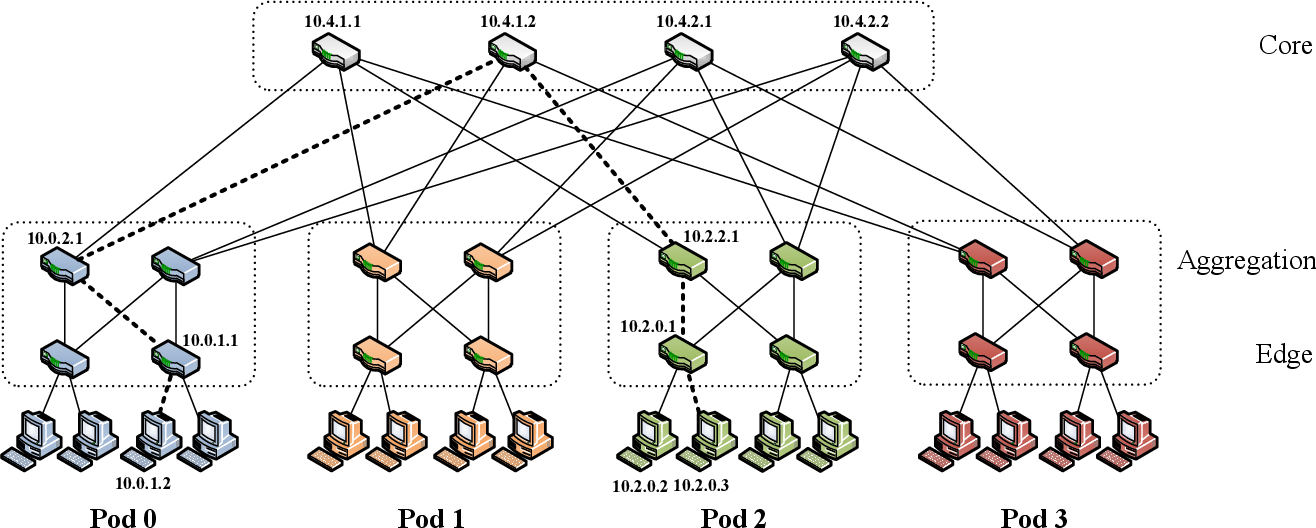This repository contains the source code for the project of the course Networking II (Softwarized and Virtualized Mobile Networks) at the University of Trento. A presentation is available with a high level description of the used methods and technologies.
Goal of the project is to develop a RYU-based SDN controller to slice the network, dynamically re-allocate services and schedule new routes in order to maintain the desired QoS. The simulation is based on Mininet, a realistic virtual network running real kernel, switch and application code on a Comnetsemu Virtual Machine.
Author: Samuele Pozzani (samuele.pozzani@studenti.unitn.it)
Software-defined networking (SDN) technology is a new approach to network architectures that enables efficient network configuration and improves performance and monitoring, mostly oriented to cloud computing. A first important step for this project consists of developing a network topology that simulates a real-world scenario in a modern data center.
The class contained in network/topology.py implements a special instance of a Clos topology called Fat-Tree to interconnect commodity ethernet switches, as described in the research article "A scalable, commodity data center network architecture" (Mohammad Al-Fares et al., 2008). The topology is described by a single parameter
IP addresses of edge and aggregation switches are 10.pod.switch.1 where switches are numbered left to right and bottom to top. Core switches IP addresses are 10.k.j.i where 10.pod.switch.serverID.
One of the most important benefits provided by the Fat-Tree topology is the path redundancy, as there are exactly
The SDN Controller is implemented using RYU SDN Framework which provides well defined APIs to manage network switches using the OpenFlow protocol version 1.5.
To provide level 3 connectivity between all the hosts in the network, RYU is configured to implement the Two-Level Routing mechanism presented in the paper, using FlowTables instead of the classical routing tables.
The first level of switches (edge) act as a filtering traffic diffuser. When the simulation starts, the edge switches are configured to ask the controller for a rule to forward the packets. The controller first checks if the source host is allowed to communicate with the destination based on the slices defined in network/params.py. If allowed by the policy, the controller installs a FlowTable entry to the edge switch to forward the packet, otherwise the packet is dropped.
The flow scheduler is started by the RYU controller and runs as a separate software thread. Its execution loop includes the following stages:
- Send OpenFlow port stats requests to core switches.
- Analyze port stats replies to estimate the presence of data flows running through the core switches. Then update the TTL field for the detected flows.
- Discover congested downlinks: more than one flows are using the same link from a core switch to a pod.
- Find available downlinks and update the FlowTable on the pod switches to re-route the traffic through an unused path.
- In case an unused path cannot be found because all the links to the pod are congested, migrate a destination service to another available host, update the network slices and the FlowTable on the pod switches to re-route traffic through an unused path.
Goal of this project is to build a Proof of Concept for the SDN technology to work for network optimization. Hence flow estimation has been implemented in a very simple form to set the context and test the controller features. A flow is detected when more data than a certain threshold is forwarded by a core switch in a given amount of time. The flow is defined by that core switch, the source pod and the destination pod (there is no distinction between different hosts generating traffic from the same pod). A downlink is considered congested when more than one flow has the same destination through the same core switch.
More sophisticated flow estimation techniques should consider the type of traffic (used protocols) the source and destination hosts, the duration, the congestion on links inside the pods, and also perform probabilistic analysis on network traffic. An implementation is described in the paper "Hedera: Dynamic Flow Scheduling for Data Center Networks" (Mohammad Al-Fares et al., 2010).
In the folder simulations, there is a series of markdown files which describe some significant simulations/experiments that have been executed to test this project, including the used parameters and the outputs from Mininet and the controller.
Some different features, improvements, adaptations, tests and experiments have been left for the future, they include:
- Implement a dynamic flow scheduling with a more sophisticated flow/traffic estimation mechanism, like Hedera.
- Develop more complex services that also require a state to be saved and migrated through the network.
- Implement fault tolerance using a protocol like Bidirectional Forwarding Detection (BFD), then test the network after the deactivation of one or more links.
Add repo to pythonpath env using:
$ export PYTHONPATH=/path/to/repoMove to services folder and build the dockerfiles using:
$ docker build -t service_migration --file ./Dockerfile.service_migration .
$ docker build -t dev_test --file ./Dockerfile.dev_test .To run the simulation, first of all set the global parameters in network/globals.py
Then, run Ryu controller using:
$ ryu run network/controller.pyCreate the network topology and start the mininet simulation using:
$ sudo python3 mininet_simulation.pyTo clean the environment and kill the Docker containers run:
$ ./services/kill_containers.sh
$ sudo mn -c To generate Doxygen documentation, install Doxygen and execute:
$ doxygen DoxyfileHTML docs will be generated inside the docs folder.
MIT License or otherwise specified. See license file for details.

